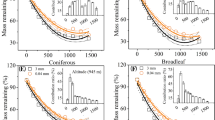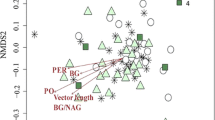Abstract
The possible effects of soil microbial community structure on organic matter decomposition rates have been widely acknowledged, but are poorly understood. Understanding these relationships is complicated by the fact that microbial community structure and function are likely to both affect and be affected by organic matter quality and chemistry, thus it is difficult to draw mechanistic conclusions from field studies. We conducted a reciprocal soil inoculum × litter transplant laboratory incubation experiment using samples collected from a set of sites that have similar climate and plant species composition but vary significantly in bacterial community structure and litter quality. The results showed that litter quality explained the majority of variation in decomposition rates under controlled laboratory conditions: over the course of the 162-day incubation, litter quality explained nearly two-thirds (64 %) of variation in decomposition rates, and a smaller proportion (25 %) was explained by variation in the inoculum type. In addition, the relative importance of inoculum type on soil respiration increased over the course of the experiment, and was significantly higher in microcosms with lower litter quality relative to those with higher quality litter. We also used molecular phylogenetics to examine the relationships between bacterial community composition and soil respiration in samples through time. Pyrosequencing revealed that bacterial community composition explained 32 % of the variation in respiration rates. However, equal portions (i.e., 16 %) of the variation in bacterial community composition were explained by inoculum type and litter quality, reflecting the importance of both the meta-community and the environment in bacterial assembly. Taken together, these results indicate that the effects of changing microbial community composition on decomposition are likely to be smaller than the potential effects of climate change and/or litter quality changes in response to increasing atmospheric CO2 concentrations or atmospheric nutrient deposition.



Similar content being viewed by others
References
Aerts R (1997) Climate, leaf litter chemistry and leaf litter decomposition in terrestrial ecosystems: a triangular relationship. Oikos 79:439–449
Allison S, Wallenstein MD, Bradford MA (2010) Soil-carbon response to warming dependent on microbial physiology. Nat Geosci 3:336–340
Anderson MJ (2001) Permutation tests for univariate or multivariate analysis of variance and regression. Can J Fish Aquat Sci 58:626–639
Austin AT, Vitousek PM (2000) Precipitation, decomposition and decomposability of Metrosideros polymorpha in native forests on Hawai’i. J Ecol 88:129–138
Ayres E, Steltzer H, Simmons BL, Simpson RT, Steinweg JM, Wallenstein MD, Mellor N, Parton WJ, Moor JC, Wall DH (2009) Home-field advantage accelerates leaf litter decomposition in forests. Soil Biol Biochem 41:606–610
Balser T, Firestone MK (2005) Linking microbial community composition and soil processes in a California annual grassland andmixed-conifer forest. Biogeochemistry 73:395–415
Burke C, Thomas T, Lewis M, Steinberg P, Kjelleberg S (2011) Composition, uniqueness and variability of the epiphytic bacterial community of the green alga Ulva australis. ISME J 5:590–600
Caporaso JG, Kuczynski J, Stombaugh J, Bittinger J, Bushman FD, Costello EK et al (2010) QIIME allows analysis of high-throughput community sequencing data. Nat Methods 7:335–336
Carney KM, Matson PA, Bohannan BJM (2004) Diversity and composition of tropical soil nitrifiers across a plant diversity gradient and among land use types. Ecol Lett 7:684–694
Carreiro MM, Sinsabaugh RL, Repert DA, Parkhurst DF (2000) Microbial enzyme shifts explain litter decay responses to simulated nitrogen deposition. Ecology 81:2359–2365
Castro H, Classen A, Austin E, Norby R, Schadt C (2010) Soil microbial community responses to multiple experimental climate change drivers. Appl Environ Microb 76:999–1007
Cavigelli M, Robertson GP (2000) The functional significance of denitrifier community composition in a terrestrial ecosystem. Ecology 81:1402–1414
Chapin FS, Matson PA, Mooney HA (2002) Principles of terrestrial ecosystem ecology. Springer, New York
Cornwell WK, Cornelissen JHC, Amatangelo K, Dorrepaal E, Eviner VT, Godoy O et al (2008) Plant species traits are the predominant control on litter decomposition rates within biomes worldwide. Ecol Lett 11:1065–1071
Couteaux M–M, Bottner P, Berg B (1995) Litter decomposition, climate and litter quality. Trends Ecol Evol 10:63–66
Crews T, Fownes J, Herbert D, Kitayama K, Mueller-Dombois D, Riley R et al (1995) Changes in soil phosphorus and ecosystem dynamics across a long soil chronosequence in Hawaii. Ecology 76:1407–1424
Daubenmire R, Prusso D (1963) Studies of the decomposition rates of tree litter. Ecology 44:589–592
Edgar RC (2010) Search and clustering orders of magnitude faster than BLAST. Bioinformatics 26:2460–2461
Fierer N, Jackson RB (2006) The diversity and biogeography of soil bacterial communities. Proc Natl Acad Sci USA 103:626–631
Fierer N, Allen AS, Schimel JP, Holden PA (2003) Controls on microbial CO2 production: a comparison of surface and subsurface soil horizons. Glob Change Biol 9:1322–1332
Fierer N, Hamady M, Lauber CL, Knight R (2008) The influence of sex, handedness, and washing on the diversity of hand surface bacteria. Proc Natl Acad Sci USA 105:17994–17999
Finzi AC, Moore DJP, DeLucia EH, Lichter J, Hofmockel KS, Jackson RB et al (2006) Progressive nitrogen limitation of ecosystem processes under elevated CO2 in a warm-temperate forest. Ecology 87:15–25
Gholz HL, Wedin DA, Smitherman SM, Harmon ME, Parton WJ (2000) Long-term dynamics of pine and hardwood litter in contrasting environments: toward a global model of decomposition. Glob Change Biol 6:751–765
Hawkes CV, Wren IF, Herman DJ, Firestone MK (2005) Plant invasion alters nitrogen cycling by modifying the soil nitrifying community. Ecol Lett 8:976–985
Henry HAL, Cleland EE, Field CB, Vitousek PM (2005) Interactive effects of elevated CO2, N deposition and climate change on plant litter quality in a California annual grassland. Oecologia 142:465–473
Hobbie SE (1996) Temperature and plant species control over litter decomposition in Alaskan tundra. Ecol Monogr 66:503–522
Hobbie SE (2000) Interactions between litter lignin and soil nitrogen availability during leaf litter decomposition in a Hawaiian montane forest. Ecosystems 3:484–494
Hobbie SE, Vitousek PM (2000) Nutrient limitation of decomposition in Hawaiian forests. Ecology 81:1867–1877
Legg TM, Zheng Y, Simone B, Radloff KA, Mladenov N, González A et al (2012) Carbon, metals, and grain size correlate with bacterial community structure in sediments of a high arsenic aquifer. FMICB. doi:10.3389/fmicb.2012.00082
Logue JB, Lindström ES (2010) Species sorting affects bacterioplankton community composition as determined by 16S rDNA and 16S rRNA fingerprints. ISME J 4:729–738
Lozupone C, Knight R (2005) UniFrac: a new phylogenetic method for comparing microbial communities. Appl Environ Microbiol 71:8228–8235
Lozupone C, Lladser ME, Knights D, Stombaugh J, Knight R (2011) UniFrac: an effective distance metric for microbial community comparison. ISME J 5:169–172
Luo Y, Hui D, Zhang D (2006) Elevated CO2 stimulates net accumulations of carbon and nitrogen in land ecosystems: a meta analysis. Ecology 87:53–63
McGuire K, Treseder K (2010) Microbial communities and their relevance for ecosystem models: decomposition as a case study. Soil Biol Biochem 42:529–535
Meentemeyer V (1978) Macroclimate and lignin control of litter decomposition rates. Ecology 59:465–472
Melillo JM, Aber JD, Muratore JF (1982) Nitrogen and lignin control of hardwood leaf litter decomposition dynamics. Ecology 63:621–626
Moorhead D, Sinsabaugh RL (2006) A theoretical model of litter decay and microbial interaction. Ecol Monogr 76:151–174
Moorhead D, Currie W, Rastetter E, Parton W, Harmon M (1999) Climate and litter quality controls on decomposition-An analysis of modeling approaches. Global Biogeochem Cycl 13:575–589
Nemergut DR, Cleveland CC, Wieder WR, Washenberger CL, Townsend AR (2010) Plot-scale manipulations of organic matter inputs to soils correlate with shifts in microbial community composition in a lowland tropical rain forest. Soil Biol Biochem 42:2153–2160
Nemergut DR, Schmidt SK, Fukami T, O’Neill SP, Bilinski TM, Stanish L, Knelman J, Darcy JL, Lynch R, Wickey P, Ferrenberg S (2013) Patterns and processes of microbial community assembly. Microbiol Mol Biol Rev 77:342–356
Norby RJ, Cotrufo MF, Ineson P, O’Neill EG, Canadell JG (2001) Elevated CO2, litter chemistry, and decomposition: a synthesis. Oecologia 127:153–165
Parton WJ, Schimel DS, Cole CV, Ojima DS (1994) A general model for soil organic matter dynamics: sensitivity to litter chemistry, texture and management. In: Bryant RB, Arnold RW (eds) Quantitative modeling of soil forming processes. Soil Science Society of America, USA, pp 47–67
Paul EA, Clark FE (1996) Soil Microbiology and Biochemistry. Academic Press, San Diego
Philippot L, Spor A, Hénault C, Bru D, Bizouard F, Jones CM et al (2013) Loss in microbial diversity affects nitrogen cycling in soil. ISME J. doi:10.1038/ismej.2013.34
Ramirez KS, Lauber CL, Knight R, Bradford MA, Fierer N (2010) Consistent effects of nitrogen fertilization on the phylogenetic composition of soil bacterial communities in contrasting systems. Ecology 91:3463–3470
Reed H, Martiny J (2007) Testing the functional significance of microbial composition in natural communities. FEMS Microbiol Ecol 62:161–170
Reed SC, Townsend AR, Cleveland CC, Nemergut DN (2010) Microbial community shifts influence patterns in tropical forest nitrogen fixation. Oecologia 164:521–531
Reed SC, Vitousek PM, Cleveland CC (2011) Are patterns in nutrient limitation belowground consistent with those aboveground: results from a 4 million year chronosequence. Biogeochemistry 106:323–336
Reeder J, Knight R (2010) Rapid denoising of pyrosequencing amplicon data: exploiting the rank-abundance distribution. Nat Methods 7:668–669
Schimel JP (2001) Biogeochemical models: implicit vs. explicit microbiology. In: Schulze ED, Harrison SP, Heimann M, Holland EA, LLoyd JJ, Prentice IC, Schimel D (eds) Global biogeochemical cycles in the climate system, Academic Press, San Diego, pp 177–183
Schimel JP, Gulledge J (1998) Microbial community structure and global trace gases. Global Change Biol 4:745–758
Schimel JP, Bennett J, and Fierer N (2005) Microbial community composition and soil N cycling: is there really a connection? In: Bardgett, RD, Hopkins DW, and Usher MB (eds) Biological diversity and function in soils, Cambridge University Press, Cambridge, pp 171–188
Strickland M, Lauber C, Fierer N, Bradford MA (2009a) Testing the functional significance of microbial community composition. Ecology 90:441–451
Strickland MS, Osburn E, Lauber C, Fierer N, Bradford MA (2009b) Litter quality is in the eye of the beholder: initial decomposition rates as a function of inoculum characteristics. Funct Ecol 23:627–636
Swift MJ, Heal OW, Anderson JM (1979) Decomposition in terrestrial ecosystems. University of California Press, Berkeley
Treseder KK, Balser TC, Bradford MA, Brodie EL, Dubinsky EA, Eviner VT et al (2012) Integrating microbial ecology into ecosystem models: challenges and priorities. Biogeochemistry 109:7–18
Vitousek P (2004) Nutrient cycling and limitation: Hawai’i as a model system. Princeton University Press, Princeton
Vitousek PM, Turner DR, Parton WJ, Sanford RL (1994) Litter decomposition on the Mauna Loa environmental matrix, Hawaii: patterns, mechanisms, and models. Ecology 75:418–429
Vitousek PM, Chadwick OA, Crews TE, Fownes JH, Hendricks DM, Herbert D (1997) Soil and ecosystem development across the Hawaiian Islands. GSA Today 7:1–8
Wang G, Post WM, Mayes MA (2012) Development of microbial-enzyme-mediated decomposition model parameters through steady-state and dynamic analyses. Ecol Appl. doi:10.1890/12-0681.1
Wickings K, Grandy AS, Reed SC, Cleveland CC (2012) The origin of litter chemical complexity during decomposition. Ecol Lett. doi:10.1111/j.1461-0248.2012.01837.x
Zak DR, Holmes WE, White DC, Peacock AD, Tilman D (2003) Plant diversity, soil microbial communities, and ecosystem function: are there any links? Ecology 84:2042–2050
Acknowledgments
We thank H. Farrington and J. Schulten for logistical and sampling support, and B. Houlton and the plant analysis lab at the University of California Davis for performing the litter lignin analyses. M. Strickland, N. Fierer and two anonymous reviewers provided valuable comments on the experiment and the manuscript. We acknowledge the generous financial support of the both the Andrew W. Mellon Foundation and the National Science Foundation (DEB—0919080). Any use of trade names is for descriptive purposes only and does not imply endorsement by the U.S. Government.
Author information
Authors and Affiliations
Corresponding author
Additional information
Communicated by Michael Madritch.
Electronic supplementary material
Below is the link to the electronic supplementary material.
Rights and permissions
About this article
Cite this article
Cleveland, C., Reed, S.C., Keller, A.B. et al. Litter quality versus soil microbial community controls over decomposition: a quantitative analysis. Oecologia 174, 283–294 (2014). https://doi.org/10.1007/s00442-013-2758-9
Received:
Accepted:
Published:
Issue Date:
DOI: https://doi.org/10.1007/s00442-013-2758-9




